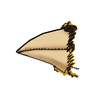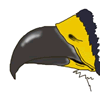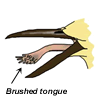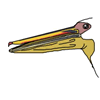Living things are found throughout the world in habitats with vastly differing environmental conditions.
An organism is more likely to survive if it has structures or behaviour which helps it obtain what it needs to survive and reproduce. We call these features adaptations, and we say that the organism is well adapted to its environment if it can survive there well.
Organisms show adaptations to assist movement, communication, survive in different climates.... life is a matter of "survival of the best adapted"!
It is of benefit to an organism if it is able to colonise a new area
or utilise a different food source because the organism then does not
have to compete against others for limited resources.
Because of this, we find even among similar organisms, such as birds,
many different varieties with different features (adaptations) offering
some benefit to aid survival.
|
Drawings not to scale
|
||
|
Birds and feet
Charles Darwin studied finches in the Galapagos Islands during his exploration on the ship, "The Beagle"(1835). He found that several species of finches co-existed on the same island because each had their own niche, eating different diets and living in different areas (e.g. ground-dwellers, tree-dwellers and so on). Each showed different adaptations specialising them for their specific roles. This prompted his Theory of Evolution Through Natural Selection (see Species and Evolution). |
 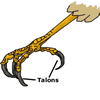 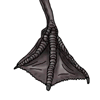 |
Same environment -
similar features
Looking at one habitat, e.g. the inter-tidal zone at the beach, most creatures
living there have some means of adhering to the rock to prevent them being
washed off by the waves. Shellfish have a strong muscular foot, sea anemones
are firmly attached and move only very small distances, and starfish have
sucker feet - all adaptations to allow them to overcome this environmental
problem.
Man and domesticated organisms
Adaptations are usually beneficial changes, but sometimes the benefits
are for us rather than the organism! By selective breeding, humans have
changed some organisms to provide themselves with more food. For example,
larger, more docile and meatier cattle produce more food for us, but these
features certainly wouldn't help a cow survive in the wild!
Selective breeding in dogs and cats for show purposes also is based on Man's preferences, and not for the individual's survival.
Via genetic engineering, Man has also modified organisms to improve such factors as yield, resistance to disease, and other characteristics which improve survival.
| Copyright owned by the State of Victoria (Department of Education and Early Childhood Development). Used with Permission. |
